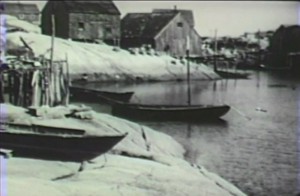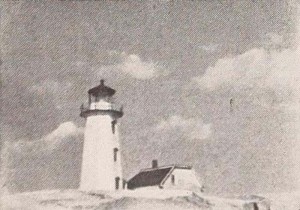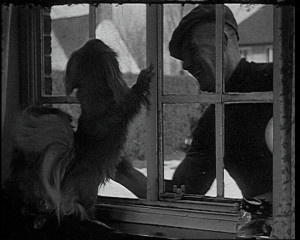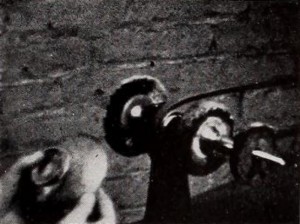
"Seldom has an amateur embarked upon so formidable a production as did David Bradley when he and some friends decided to film Ibsen's Peer Gynt, using Grieg's music for background. This mystic drama is considered so difficult that it has been performed only twice in the American theatre; yet the task held no terror for this group. Fashioning their own costumes and finding suitable locations in suburban Chicago, Mr. Bradley's intrepid band has done an amazingly good job. It would be easy to visualize the result had the production been in less capable hands than those of Mr. Bradley, and it is to his great credit that such quaint characters as the Button Moulder and the many trolls and woodland sprites do not appear ludicrous. The chief fault in this tremendous undertaking is that Ibsen's gigantic play has been transliterated to the screen rather than translated. That is, Mr. Bradley, by his own admission, modeled his scenario as closely as possible on a work written expressly for the theatre. Had he taken more liberties with the dramatic form in favor of a more peculiarly cinematic treatment — as exemplified so strikingly in the fine Hall of the Mountain King sequence — there would have been no structural weaknesses in his film. With this fundamental concept firmly in mind, Mr. Bradley, recently turned twenty one, should scale the heights in his future productions." Movie Makers, Dec. 1941, 566.

"In Ultima Thule and Peggy's Cove, produced by Edward A. Bollinger, ACL, and Mrs. Bollinger, one finds what must be the ultimate in beautiful scenic photography, magically infused throughout with a sensitive feeling for the relationship of ordinary people to their natural backgrounds. Beyond the veritable perfection of many of the scenes in these pictures it seems impossible for camera and film to go, even when guided by skill and imagination as superb as Mr. and Mrs. Bollinger's. Compositions, cutting and sequence structure are incisive and stirring, while the title wordings and execution leave little to be desired in suave good taste. The two subjects are first and last reels of a four reel study of Nova Scotia, in which, it is understood, Mr. Bollinger has done the camera work and his wife the editing and titling. It is a happy combination, from which have resulted documentary reels of magnificent skill and breathtaking beauty." Movie Makers, Dec. 1935, 550.

"Francis M. Hirst's Peggy's Cove is 8mm. scenic cinematography of a very fine kind. This familiar movie subject for personal filmers is given added interest and beauty by Mr. Hirst's handling of it. He has not departed from the high standard set by Edward Bollinger in the first of the many Peggy's Coves to be offered for Ten Best. While Mr. Bollinger had the advantage of a larger frame size, Mr. Hirst had the added factor of color, and he makes the most of it, hurdling the problem of distant shots in 8mm. Kodachrome in gallant fashion. Here we have the sincere recording, by an artist with an instant eye for beauty, of a locale that will, for years to come, invite the attention of filmers who wish to match their art against a distinguished subject." Movie Makers, Dec. 1939, 635.

"Film of two Pekinese dogs at home and in the country, detailing their development as they age. Set in the garden and the home of Laurie and Stuart Day, as well as in surrounding countryside, the film makes use of seasonal changes to record the ageing of two Pekinese dogs" (EAFA Database).
"The Pelican colony at Stum Lake in the Chilcotin Region." (BC Archives)
"Film is about how the cost of living increases especially affecting seniors or those on pensions. Among the cast are Jack Davidson as the pensioner and Jean Phillips as his wife. Music by students of Langstaff Secondary School" Archives of Ontario.

"As indicated by the title, Miss Webb-Smith has built her picture around people; street scenes of people going about their business, children at play, girls with heavy loads on their heads, laundry activities along the river shore, also some views of the architecture, cork harvest and processing. She lets us feel that w have visited Portugal" PSA Journal, Oct. 1961, 49.
"The Island of Rhodes lies in the Agean Sea off the coast of Greece. Its barren, rocky terrain is home to the strong and hard working people, who have weathered the centuries with little change, in spite of the historical remnants of past invaders. They lead a hard, simple and religious life, but when an occasion arises, all join in the festivities of the celebration, roasting whole lambs over charcoal pits and preparing the delicacies for the general feast. The contrast is stark as a great modern ocean liner glides out of the ancient harbor that once was guarded by one of the Seven Wonders of the World - the Colossus of Rhodes" PSA Journal, Oct. 1963, 40.

"Helen H. Loeffler has the distinction of being the only woman among those whose films placed in this year's Ten Best selection. Permanent Color is a workmanlike film record of applying vitreous enamel to metal in the production of decorative objects. The movie is replete with well lighted closeups of each operation, from making the vessels of copper to the final polishing after the enamel has been baked. Explanatory titles of the various steps are well handled, and scenes of the finished products provide a colorful ending." Movie Makers, Dec. 1944, 496.
Total Pages: 299